Enhanced TDS
Knowde-enriched technical product data sheet
Identification & Functionality
- Chemical Family
- Cleaning Ingredients Functions
- Technologies
- Product Families
Features & Benefits
- Labeling Claims
- HII Features
- Product Highlights
- Clear visually appealing gels
- Shear thinning
- Structuring & suspension
- High fragrance loading
- Used as water-soluble rim block
- It can be used to add structure to aqueous formulations
CrystaSense HP5 can be used to thicken acidic hard surface cleaners containing up to
- Citric acid
- Phosphoric acid
- Methane sulphonic
- Oils & Fragrance
Air Care
All the CrystaSense rheology modifiers can be used to produce visually appealing air fresheners featuring high fragrance loading and innovative design possibilities, with steady, predictable fragrance release. The system can be used in the same way to gel insect repellents. The most suitable CrystaSense polymer depends on the polarity of the fragrance and compatibility with other formulation ingredients.Water-Based Air Fresheners
The CrystaSense LP, MP, HP series can also be used for water-based air fresheners - CrystaSense HP5 is most suitable for this application. In water-based air fresheners water is used as a diluent and therefore the formulation has a reduced cost, as well as a potential reduction in emissions of volatile organic compounds (VOCs). Water-based air fresheners are clear and firm, and insoluble in water.Toilet Rim Blocks
All the rheology modifiers can be used to formulate air fresheners for integration into toilet care products, such as rim blocks. Water-resistant oil-based rim blocks can be formulated using CrystaSense LP1, LP2 or LP3, and water-soluble formulations use CrystaSense HP4 or HP5. Water-soluble formulations will release active with
each flush and will eventually dissolve entirely, indicating to the consumer that the product has reached the end of its lifetime. CrystaSense HP5 gives a slower dissolution than CrystaSense HP4; therefore the dissolution rate can be controlled by a combination of the two polymers. Both formulations can be used alone in a rim
block cage or can be integrated into a dual-use formulation which contains separate bars of other water-soluble actives.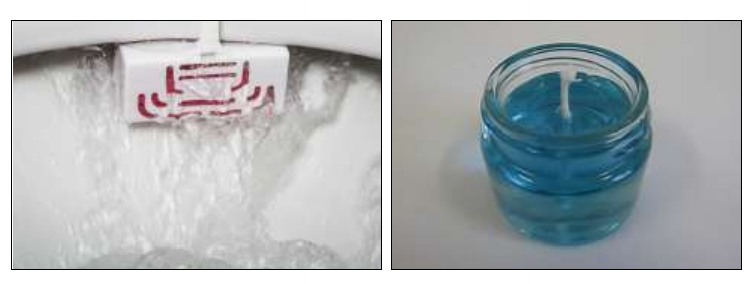
Candles
CrystaSense LP1 and LP3 can both be used to gel mineral oil, therefore making them ideal for use in vibrant clear gel candles. The CrystaSense rheology modifiers will gel formulations containing mineral oil, dye and fragrance and will burn steadily throughout the candle’s lifetime. Liquid fatty acids such as Priolene™ 6907 and Prisorine™ 3501 are used to bring clarity to the formulations at low polymer concentrations. Figure 2 shows a candle made with 20% CrystaSense LP3.- Air Care
- Used to create water-soluble rim blocks
- Controlled dissolution rate
- Product fully dissolves to show end-of-life
- Surfactants & Aqueous Systems
Hard surface cleaners
Thickened hard surface cleaners are ideal for vertical surfaces due to the increased contact time. This allows for a reduction in surfactant levels, milder pH levels and improved consumer usability. Gelled formulations appear more concentrated and dosage can be more predictable, appealing to the consumer. CrystaSense HP5 can be used in conjunction with Croda surfactants in thickened cleaners for hard surfaces; these can be nearneutral, acidic or alkaline. The viscosity of the gels can be carefully controlled by the concentration of the polymer in the formulation. Figure 3 shows results of spraying a control formulation based on NatSurf™ 265 and the same formulation containing 3% CrystaSense HP5. The results show that the formulation containing CrystaSense HP5 has a much longer contact time with the tile.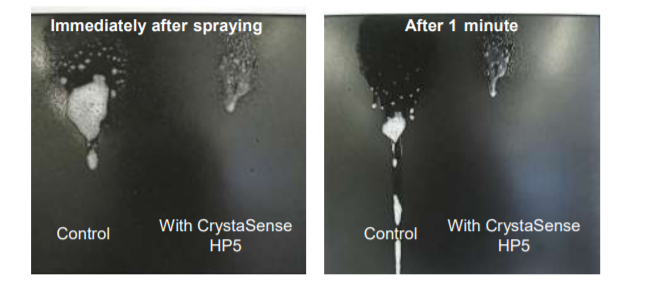
Figure 3: Contact time comparison between two formulations sprayed onto a tile – one with CrystaSense HP5 (right) and one without (left).
Compatibility of CrystaSense HP5 with nonionic surfactants was measured and the compatible Croda surfactants are shown in Figure 3. Nonionic surfactants with HLB values of 12.5 – 14.8 such as those below were found to be compatible.
Product HLB Synperonic™ 91/5 12.5 Synperonic 91/6 13.4 NatSurf™ 265 13.5 NatraSense™ AG-810 13.6 Synperonic 91/8 13.9 Synperonic A11 13.9 NatraGem™ S140NP 14.0 Synperonic 91/10 14.7 Synperonic 13/12 14.8 Table 3: Nonionic Croda surfactants that are compatible with CrystaSense HP5
Acidic Cleaners
Thickened hard surface cleaners are valuable for household applications but also I&I applications where acidic cleaners are used on heavy duty soils such as limescale and traffic film on automotive wheels. Large areas of vertical surfaces are often difficult to clean with mechanical action, therefore any cleaning solutions need to be highly effective - increased contact time for acid cleaners will equate to cleaner surfaces. CrystaSense HP5 has been tested for compatibility with acids commonly used in industrial cleaning and has been found to be compatible with citric acid, phosphoric acid and methanesulphonic acid. CrystaSense HP5 can be used for up to 20% acid concentrations and will thicken at below pH 0.1. Recommended inclusion depends on desired viscosity, but is approximately 1.0 – 3.5% active.
Suspensions
CrystaSense HP5 is also suitable for suspending encapsulated material such as fragrance, or performance additives that are not compatible with the base formulation. As well as allowing formulation with incompatible materials, suspensions made with the CrystaSense HP5 rheology modifier will look striking in the bottle. The flow of the formulation will depend on the concentration of polymer – lower concentrations will give good flow and higher concentration will give more rigid gels.
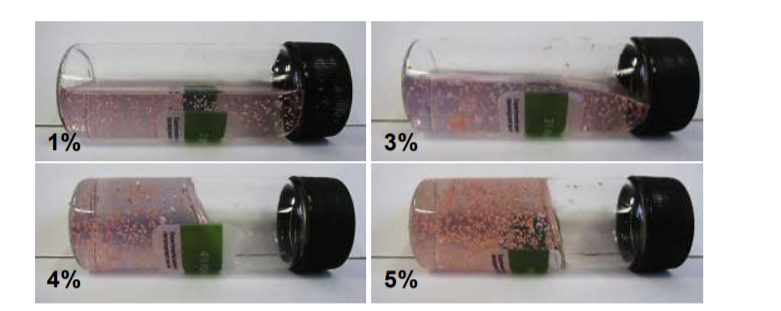
- Hard Surface Cleaning
- Thickener for concentrated acidic formulations
- Increased surface contact time
- Enhanced heavy duty soil removal
- Wide range of acid compatibilities
- Less rinsing required
- Consistent, predictable dosing
- Reduced surfactant levels required
- Good suspending properties
Applications & Uses
- Markets
- Applications
- Home Care Applications
- I&I Cleaning Applications
- Applications
- Air care
- Toilet care
- Hard surface cleaners
- I&I cleaners
- Recommended Uses
Air fresheners Most suitable Water-based air fresheners Most suitable Water-soluble rim blocks Also recommended Hard surface cleaners Most suitable Acidic cleaners Most suitable Concentrated surfactant systems Most suitable Suspensions Most suitable Table 2: The CrystaSense series rheology modifiers are each suited to particular uses due to their chemistry and compatibilities
- Formulating
CrystaSense HP are solid colorless wax-like pastilles and therefore require heating for processing. For example, to produce an air freshener all ingredients except volatile components must be mixed and heated to at least the softening point of the CrystaSense component. The mixture is then cooled to a suitable temperature and the volatile ingredients are added. The mixture is then poured into molds; full gel strength is obtained after approximately two hours at room temperature.
Formulation Examples
Air Care
- Water-Resistant Fragrance Rim Block with CrystaSense LP1 HC/AF/11
- Water-Soluble Fragrance Rim Block with CrystaSense HP4 HC/AF/12
- Glitter Gel Candle with CrystaSense LP3 HC/AF/13
- Water-Based Gel Air Freshener with CrystaSense HP5 HC/AF/14
Hard Surface
- Spray & Stick Acidic Hard Surface Cleaner with CrystaSense HP5 HC/HS/85
- Acidic Hard Surface Cleaner Thickened with CrystaSense HP5 HC/II/22
Properties
- Physical Form
- Typical Properties
Value Units Test Method / Conditions Color Value (Gardner) max. 6 - - Acid Value max. 15 mg KOH/g DIN EN ISO 2114 Amine Number max. 3 - - Molecular Weight 19000 - - Softening Point 93 °C - Type PAOPA
Technical Details & Test Data
- Clearly Superior Gellants
- The CrystaSense LP, MP, HP Series consists of six unique patented amide polymers designed for use as rheology modifiers in a wide range of formulation types and formats.
- The gellants are chemically inert and work by forming a three dimensional structure, locked in by hydrogen bonding. Oil is attracted to the fatty dimer acid chains and the hydrophobic pockets that are formed trap the oil. The strength, or hardness, of the gel is controlled by the polymer concentration and molecular weight of the gellant.
- Compatibility
- Oils & fragrance
- Surfactants & aqueous systems
- Acidic formulations
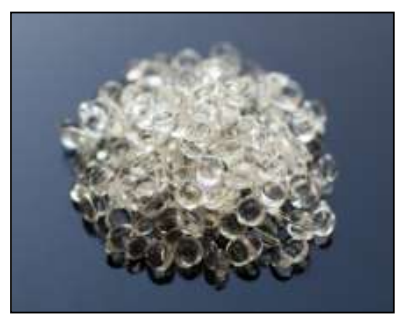
- Polymer Selection
As each CrystaSense gellant has different chemistry, the series has a wide range of compatibilities with other ingredients. A suitable gel can be chosen depending on the other ingredients in the formulations, what the intended application of the product is, and the ideal physical characteristics. Figure 5 shows a variety of common ingredients and the CrystaSense amide polymer that is likely to show compatibility with that ingredient, based on polarity.
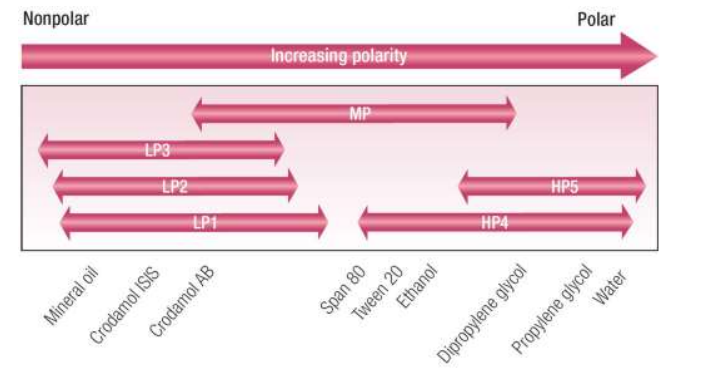
Figure 5: Common ingredients and their compatibility with the CrystaSense HP series
The properties of gels made with CrystaSense rheology modifiers vary depending on a number of factors. Table 2 shows how the physical properties of the gels change by increasing or decreasing concentration and the molecular weight of the rheology modifier.
System Compatibility Decreased molecular weight = Increased compatibility Gel Strength Increased concentration = Increased gel strength
Increased molecular weight = Increased gel strengthGel Clarity Increased concentration = Increased gel clarity
Decreased molecular weight = Increased gel clarityTable 4: The physical properties of gels made with the CrystaSense rheology modifiers change with varying concentrations
Packaging & Availability
- Country Availability
- Regional Availability